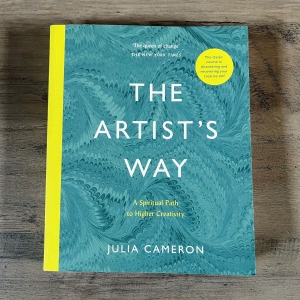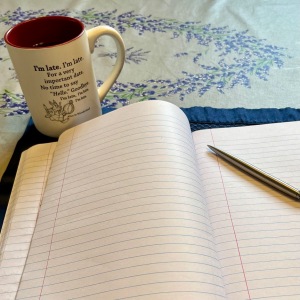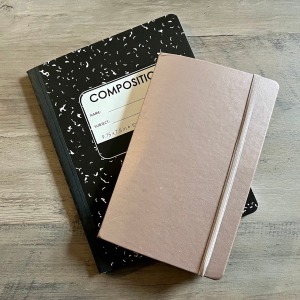Towards the end of 2021, a writer friend shared that she planned to work with The Artist’s Way. I’d never heard of Julia Cameron or this book before, so I was curious about it. Since we were discussing how we both wanted to write more going forward, I decided it might be worthwhile to see if this book would help me achieve that end. When in a pandemic and dealing with another surge and some unpleasant life stuff, jumping feet first into a new endeavor sounds fun—especially if it helps your writing life. So, without further ado (that is, reading up on it), I ordered it and planned to get underway in January.
Nothing like leaping before you look, right?

What is The Artist’s Way?
It’s a self-help book based on classes that Julia Cameron teaches on creativity. Meant to be used by any artist (from the hobbyist to the professional), it does not focus on a specific art form, although writing does feature in it (more on that shortly). Cameron doesn’t teach creativity per se, so much as she encourages her readers to allow themselves to be creative. For this reason, the book works on what undermines people from embracing their creativity and provides various techniques to encourage/explore creativity.
People who study certain subjects (psychology, philosophy/religion), attend therapy, or belong to 12-step programs (the course is 12 weeks, which I doubt is coincidental) may recognize some techniques from these disciplines. The benefit here is that these various ideas are specifically aimed at living a more artistic lifestyle. Spirituality is heavily emphasized, as is the belief that all of us are meant to be creative (a central tenet). Overall, this book focuses on helping its readers to live a more artistic life.
The Good: Tools for Growing as an Artist
Morning Pages
The Artist’s Way provides two tools (meant to work together) to use throughout the 12-week course and, ideally, going forward: morning pages and the artist’s date. Morning pages, as the name suggests, should be completed every morning upon awakening.[*] Whether the reader happens to be a pianist or a sculptor, they must sit down and write three sides of paper (that is, 1.5 pages) of text by hand every morning. Generally, no one should look at them—not even their composer initially.

The purpose of these pages is a more difficult to explain. Their job, much like a first draft, is to exist. They don’t have to be about anything specific or planned, just what comes to mind. By getting them done early, it allows you to express yourself less critically, regardless of your mood. They may reveal problematic patterns in your life, provide inspiration, or be an outlet for your complaints, but primarily they help you clear your mind.[†] Cameron describes them alternately as meditation or prayer.
The Artist’s Date
If morning pages are a freewheeling process designed to get your thoughts on the page, the artist’s date is about doing. Much like morning pages, the second tool should not be missed but be performed weekly (around two hours, although a specific time is not required). The artist’s date requires you to go on something like a solo playdate. The idea is to experiment with things that interest you, which don’t have to be especially artistic.

While what you do on the date varies (this depends on the reader’s tastes but there are exercises that provide inspiration), the goal is to help you refill your artistic well (that is, replenishing your source for creativity) by observing and experiencing. Some examples of artist’s date can include taking a walk, cooking a new dish, visiting a museum, etc. Cameron notes that artist’s dates can provide solutions to concerns that come up during morning pages.
Benefits of These Tools
Both tools have the potential to help readers working on their artistic recovery (that is, embracing their creativity). Arguably, we all have artistic blocks that prevent us from creating, whether it’s holding us back in our artistic expression or preventing us from being creative at all. Using these tools can help expose those blocks (morning pages) and work through them by allowing yourself to do fun things (artist’s dates).
Potential Challenges
In the introduction, Cameron announces that she uses the term God throughout (accurately), but the reader can interpret “God” however they choose. She is clear that she does not want or expect people to believe in God if they don’t or aren’t sure about that concept (she suggests the workaround of viewing God as short for “good orderly flow”). I would’ve preferred that she more liberally used generic terms (eg, the universe or even higher power) to be inclusive and more neutral, but the burden is really on the reader to work around the terminology if it makes them uncomfortable. Although she insists her version of God is benevolent, I doubt her assurance erases the reader’s constructs of God, religion, and spirituality that term evokes, for better or worse. Week 3, which involves a more in-depth discussion of God, may prove challenging for some.
Some Minor Difficulties
The Artist’s Way is meant to be used creatively, with readers having a lot of freedom to use Cameron’s suggestions as works best for them. As such, it was not designed to operate as a traditional textbook, but there are areas where I wished there was more guidance present. I ran into a few minor difficulties trying to find information and instructions.

Cameron states in an early chapter called “The Basic Tools” that there’s “no wrong way to do morning pages” and suggests writing on loose pages and storing them in an envelope or using a spiral notebook .[‡] With the idea that any approach would work, I initially decided to use a comparably sized composition notebook as that works better for me. However, the first two tasks in week 1—when you presumably get underway with these pages—specifically refer to loose paper stored in an envelope. Fearing I misunderstood, I went hunting for the instructions on morning pages, which took some time to find as I forgot that they were in the aforementioned chapter (the index eventually led me back). But better instructions here would have saved me the bother. If the paper choice isn’t set in stone, the associated tasks should reflect that freedom (eg, it could state the notebook cover or envelope could get a star for task 2 of week 1).

Admittedly, this is a mild quibble, but there are other instances where more detail would be helpful. When you encounter tasks for the first time, there are no instructions provided about how to do them, because this was again discussed previously in the chapter called “Spiritual Electricity: The Basic Principles”. Here, referring to that chapter (as is done elsewhere: tasks 1 and 5 refer in week 2 refers you back to week 1’s affirmations) or just restating the instructions would be useful. With that in mind, the reader might need to be more diligent about taking notes or highlighting specific instructions.
I should also note there are some potential areas of confusion when it comes to some ideas and topics. Morning pages, as discussed above, are hard to describe, because potential use cases and benefits may vary depending on the person and their specific blocks or challenges—which is fair. However, Cameron does occasionally hint at topics that will be discussed in more depth later. Flagging such instances as future topics would be ideal, as I found myself wondering what she meant or whether this was an important practice.[§] Again, it might be best to be patient with the process or just look up items in the index if you want the description immediately.
My Own Journey with Artist’s Way Up to Week 3
Having made the plunge and purchased the book without investigating what it offered, I likely expected something more focused on writing than artistic recovery. I also missed the “spiritual path” part, which normally I would hesitate to buy. As a rule, I avoid discussing various religious or spiritual belief/disbelief systems for various reasons that include weariness with such discussions.
Since I made the commitment to try something new,[**] I decided to continue onward despite my trepidation. As soon as I began reading the prefatory chapters, this book turned up in numerous places online—and another writer friend also started working with it. It seemed like a sign I should give it a chance. As with many self-help books, it’s useful to have a read, learn from what works, and ignore what doesn’t. So far, the morning pages seem helpful when it comes to meeting my goal to write regularly, although I’m not sure I’ve had enough artist’s dates to comment on their effect.
Going forward, I will continue to skip reading ahead as it’s a bit more adventurous this way—plus it allows me fewer opportunities to avoid anything else that’s challenging but negotiable. And, having just completed week 4, this choice already proved to be a good one, as this particular lesson was sufficiently challenging (though negotiable) to merit its own post, which I’ll link to when I finish writing it.
NOTES:
[*] Acquiring caffeine first is permitted and is, in my opinion, mandatory. Under the tasks for week 1, she also suggests getting up half hour earlier to do your morning pages, which I cheerfully ignored as I’m a night owl.
[†] For writers, there is the additional benefit of establishing a daily writing practice, which potentially could extend into establishing a more regular creative writing practice. This is one reason I’m interested in continuing onward with this course.
[‡] Her website offers clearer, perhaps more prescriptive suggestions about morning pages that you can find here and here. For the artist’s date, some more information can be found here.
[§] The most intriguing instance of this (thus far) involves a task in week 4, which asks you to create an altar. Here, it states the altar reminds us creativity is a spiritual versus ego issue. Using an altar and its purpose were not mentioned let alone discussed in any detail previously, which made this task seem out of place. However, the index suggests this conversation will occur in about 100 more pages, so I assume their relevance will become clearer then.
[**] Yes, I’m familiar with the sunk cost fallacy, but I think a trial in such cases can be worthwhile before you decide whether it’s prudent to cut your losses.

